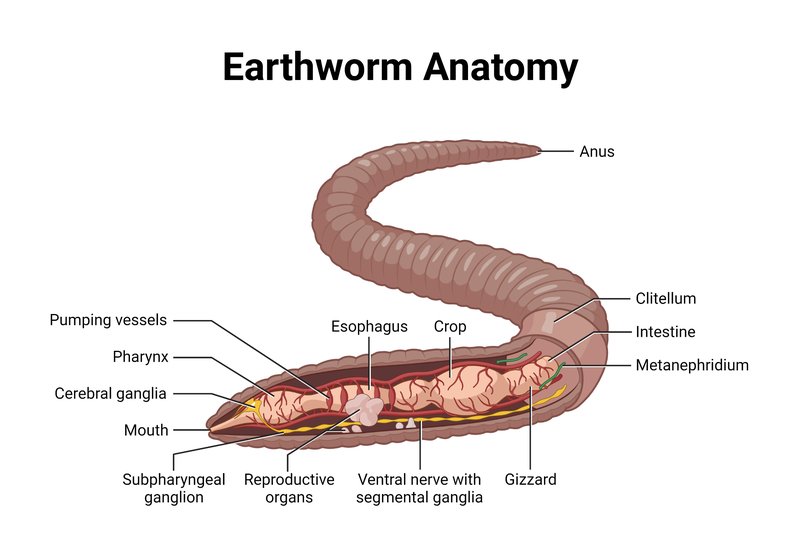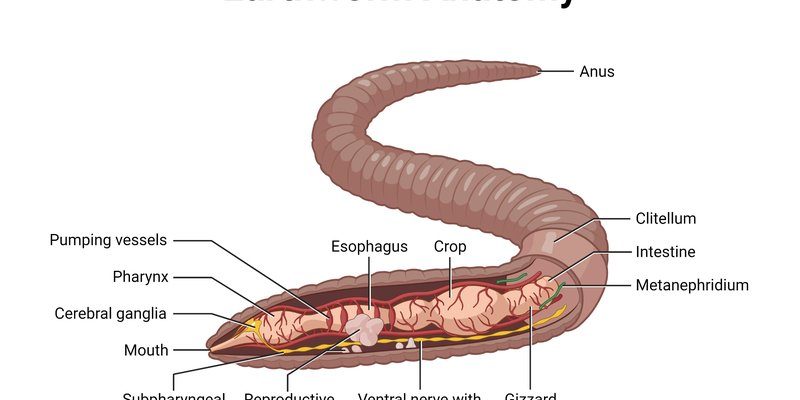
If you’ve ever wondered how earthworms eat, move, or even breathe, you’re in for a treat. Their bodies are fascinating, filled with segments, setae, and gizzards that play crucial roles in their survival. So grab your favorite drink, and let’s dig into the inner workings of these incredible little creatures!
Understanding Earthworm Segmentation
One of the first things you’ll notice when observing an earthworm is its **segmented body**. Think of it like a long, flexible train made up of individual cars, each carrying out its own special tasks. An earthworm’s body is divided into many segments, usually ranging from 100 to 150. Each segment has its own muscles, which help the worm move effectively through the soil.
The segmentation is vital for the worm’s flexibility and mobility. When one segment contracts, the worm can push or pull itself forward, burrowing deeper into the earth. This movement is crucial for not only finding food but also for avoiding predators. If you’ve ever seen an earthworm wriggle away quickly, you’ve witnessed this segmental motion in action!
It’s also interesting to note that some segments, particularly the anterior (front) segments, are larger and more muscular than others. These segments help the worm anchor itself while the others push forward. Just like using your upper body to climb while the rest of your limbs push you up a hill, earthworms leverage their segments to navigate their environments effectively.
The Role of Setae in Movement
If you looked closely at an earthworm, you’d see tiny bristle-like structures sticking out from its body. These are called **setae**. Imagine them as the worm’s tiny gripping tools. Each segment of an earthworm typically has four pairs of setae that help it grip the soil and maintain traction as it moves along.
You might be wondering why setae are so important. When an earthworm burrows, it needs to push against soil particles to create a tunnel. The setae help the worm anchor itself in place while it contracts its muscles to move forward. Without these little bristles, the earthworm would have a tough time digging through the earth!
Setae also contribute to how earthworms can effectively navigate different terrains. Whether it’s soft mud or compacted soil, the setae provide the necessary grip to ensure they can move. It’s like wearing the right shoes for hiking on various trails — it makes all the difference!
Exploring the Gizzard: The Earthworm’s Stomach
Now, let’s talk about one of the most intriguing parts of an earthworm—the **gizzard**. This muscular organ is located right after the crop, which is where food is initially stored. Think of the gizzard as a natural blender. It grinds up the organic material the worm eats, such as decaying leaves and soil.
Earthworms don’t have teeth like we do, so the gizzard performs the critical job of breaking down food into smaller bits that can be digested. It contains small particles of grit or sand, which help in grinding up the food effectively. This process is essential because it allows the earthworm to absorb more nutrients from the organic matter they consume.
The gizzard operates in conjunction with the rest of the digestive system, which includes the mouth and crop. The food starts in the mouth, then moves to the crop for storage, and finally arrives at the gizzard for grinding. It’s a simple yet effective system that ensures earthworms can thrive on a diet of decomposing matter.
The Digestive System of an Earthworm
Understanding the complete **digestive system** of an earthworm gives us insight into how these creatures contribute to the ecosystem. After the gizzard, the food moves to the intestine, where digestion is completed, and nutrients are absorbed. The lining of the intestine has many folds, maximizing the surface area for nutrient absorption.
Once nutrients are absorbed, the leftover material is pushed out. Earthworms excrete nutrient-rich castings, which enrich the soil and improve its structure. This process is vital for healthy soil and plant growth, making earthworms nature’s little recyclers.
You might not realize it, but every time you see an earthworm in your garden, it’s helping to make the earth healthier. So, the next time you spot one, remember they’re not just slimy creatures — they’re hardworking little helpers!
The Nervous System and Sensory Responses
Earthworms might not have a brain like we do, but they do have a **nervous system** that helps them respond to their environment. Their nervous system consists of a simple brain made up of nerve cells and a ventral nerve cord that runs along the length of their body.
Interestingly, earthworms rely heavily on other sensory organs to navigate through their underground world. For instance, they have light-sensitive cells that help them detect changes in light, which is crucial for avoiding surface areas where predators might be lurking. They also have cells that can detect moisture and chemicals in the soil, enabling them to find food efficiently.
The way earthworms respond to stimuli is quite fascinating. If a worm is touched or feels a disturbance, it will often retract and wiggle away quickly. This reflex action is essential for survival, helping them escape threats and navigate their environment safely.
Learning about **earthworm anatomy** goes beyond just curious exploration; it helps us appreciate the incredible roles these creatures play in our ecosystems. By understanding their segments, setae, and gizzards, we gain insight into how they contribute to soil health and plant growth.
Earthworms are more than just garden visitors; they are essential for a thriving environment. The next time you see one slithering by, take a moment to recognize the complex systems at play inside their tiny bodies. Just like small gears in a well-oiled machine, every part of the earthworm works together to keep nature moving smoothly. So, let’s celebrate these remarkable little beings and the vital jobs they do!

